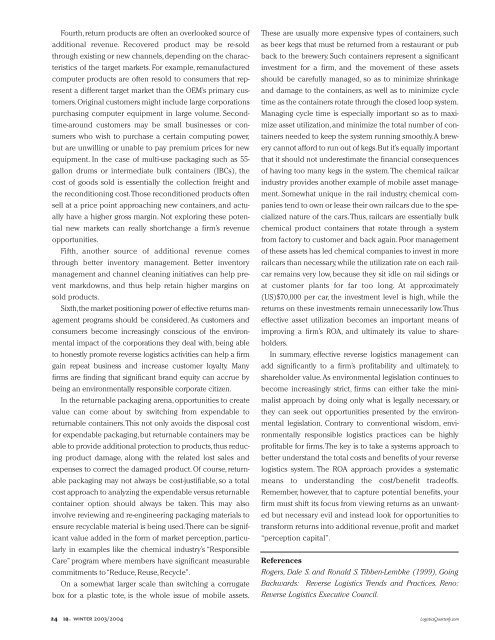Reverse Logistics - Logistics Quarterly
Reverse Logistics - Logistics Quarterly
Reverse Logistics - Logistics Quarterly
You also want an ePaper? Increase the reach of your titles
YUMPU automatically turns print PDFs into web optimized ePapers that Google loves.
Fourth,return products are often an overlooked source of<br />
additional revenue. Recovered product may be re-sold<br />
through existing or new channels,depending on the characteristics<br />
of the target markets. For example, remanufactured<br />
computer products are often resold to consumers that represent<br />
a different target market than the OEM’s primary customers.Original<br />
customers might include large corporations<br />
purchasing computer equipment in large volume. Secondtime-around<br />
customers may be small businesses or consumers<br />
who wish to purchase a certain computing power,<br />
but are unwilling or unable to pay premium prices for new<br />
equipment. In the case of multi-use packaging such as 55gallon<br />
drums or intermediate bulk containers (IBCs), the<br />
cost of goods sold is essentially the collection freight and<br />
the reconditioning cost.Those reconditioned products often<br />
sell at a price point approaching new containers, and actually<br />
have a higher gross margin. Not exploring these potential<br />
new markets can really shortchange a firm’s revenue<br />
opportunities.<br />
Fifth, another source of additional revenue comes<br />
through better inventory management. Better inventory<br />
management and channel cleaning initiatives can help prevent<br />
markdowns, and thus help retain higher margins on<br />
sold products.<br />
Sixth,the market positioning power of effective returns management<br />
programs should be considered. As customers and<br />
consumers become increasingly conscious of the environmental<br />
impact of the corporations they deal with, being able<br />
to honestly promote reverse logistics activities can help a firm<br />
gain repeat business and increase customer loyalty. Many<br />
firms are finding that significant brand equity can accrue by<br />
being an environmentally responsible corporate citizen.<br />
In the returnable packaging arena, opportunities to create<br />
value can come about by switching from expendable to<br />
returnable containers.This not only avoids the disposal cost<br />
for expendable packaging,but returnable containers may be<br />
able to provide additional protection to products,thus reducing<br />
product damage, along with the related lost sales and<br />
expenses to correct the damaged product. Of course, returnable<br />
packaging may not always be cost-justifiable, so a total<br />
cost approach to analyzing the expendable versus returnable<br />
container option should always be taken. This may also<br />
involve reviewing and re-engineering packaging materials to<br />
ensure recyclable material is being used.There can be significant<br />
value added in the form of market perception, particularly<br />
in examples like the chemical industry’s “Responsible<br />
Care” program where members have significant measurable<br />
commitments to “Reduce, Reuse, Recycle”.<br />
On a somewhat larger scale than switching a corrugate<br />
box for a plastic tote, is the whole issue of mobile assets.<br />
24 LQ winter 2003/2004<br />
These are usually more expensive types of containers, such<br />
as beer kegs that must be returned from a restaurant or pub<br />
back to the brewery. Such containers represent a significant<br />
investment for a firm, and the movement of these assets<br />
should be carefully managed, so as to minimize shrinkage<br />
and damage to the containers, as well as to minimize cycle<br />
time as the containers rotate through the closed loop system.<br />
Managing cycle time is especially important so as to maximize<br />
asset utilization,and minimize the total number of containers<br />
needed to keep the system running smoothly.A brewery<br />
cannot afford to run out of kegs.But it’s equally important<br />
that it should not underestimate the financial consequences<br />
of having too many kegs in the system.The chemical railcar<br />
industry provides another example of mobile asset management.<br />
Somewhat unique in the rail industry, chemical companies<br />
tend to own or lease their own railcars due to the specialized<br />
nature of the cars.Thus, railcars are essentially bulk<br />
chemical product containers that rotate through a system<br />
from factory to customer and back again. Poor management<br />
of these assets has led chemical companies to invest in more<br />
railcars than necessary,while the utilization rate on each railcar<br />
remains very low, because they sit idle on rail sidings or<br />
at customer plants for far too long. At approximately<br />
(US)$70,000 per car, the investment level is high, while the<br />
returns on these investments remain unnecessarily low.Thus<br />
effective asset utilization becomes an important means of<br />
improving a firm’s ROA, and ultimately its value to shareholders.<br />
In summary, effective reverse logistics management can<br />
add significantly to a firm’s profitability and ultimately, to<br />
shareholder value.As environmental legislation continues to<br />
become increasingly strict, firms can either take the minimalist<br />
approach by doing only what is legally necessary, or<br />
they can seek out opportunities presented by the environmental<br />
legislation. Contrary to conventional wisdom, environmentally<br />
responsible logistics practices can be highly<br />
profitable for firms.The key is to take a systems approach to<br />
better understand the total costs and benefits of your reverse<br />
logistics system. The ROA approach provides a systematic<br />
means to understanding the cost/benefit tradeoffs.<br />
Remember, however, that to capture potential benefits, your<br />
firm must shift its focus from viewing returns as an unwanted<br />
but necessary evil and instead look for opportunities to<br />
transform returns into additional revenue,profit and market<br />
“perception capital”.<br />
References<br />
Rogers, Dale S. and Ronald S.Tibben-Lembke (1999), Going<br />
Backwards: <strong>Reverse</strong> <strong>Logistics</strong> Trends and Practices. Reno:<br />
<strong>Reverse</strong> <strong>Logistics</strong> Executive Council.<br />
<strong>Logistics</strong><strong>Quarterly</strong>.com







